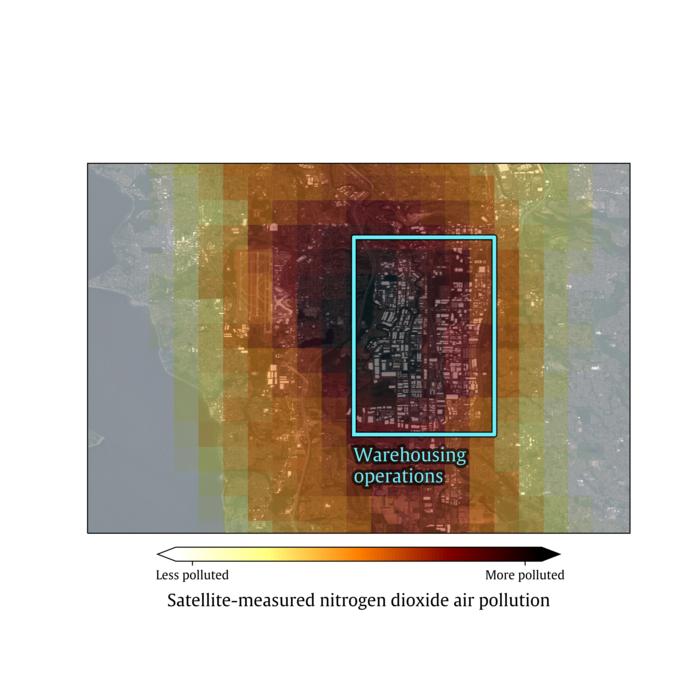WASHINGTON (July 24, 2024)–America’s demand for products delivered to the doorstep has led to a dramatic increase in e-commerce and the warehousing industry.

Credit: Gaige Kerr, George Washington University
WASHINGTON (July 24, 2024)–America’s demand for products delivered to the doorstep has led to a dramatic increase in e-commerce and the warehousing industry.
A first-of-a-kind study now shows that people living in communities located next to these large warehouses are exposed to 20% more of a traffic-related air pollutant that can lead to asthma and other life-threatening health conditions.
“Increased truck traffic to and from these recently built large warehouses means people living downwind are inhaling an increased amount of harmful nitrogen dioxide pollution,” said Gaige Kerr, lead author of the study and an assistant research professor of environmental and occupational health at the George Washington University Milken Institute School of Public Health. “Communities of color are disproportionately affected because they often live in close proximity to warehouses, especially dense clusters of warehouses.”
Kerr and his colleagues measured a traffic-related pollutant called nitrogen dioxide by using a satellite instrument from the European Space Agency to zero in from space on the nearly 150,000 large warehouses located across the United States. Trucks and other vehicles traveling to and from these large warehouses spew out nitrogen dioxide, particulates, and other harmful pollutants.
The researchers also looked at traffic information from the Federal Highway Administration and demographic data from the US Census Bureau.
Additional key findings of the study:
- Although the average spike of nitrogen dioxide associated with warehouses was 20%, nitrogen dioxide levels near warehouses were even larger when there was greater heavy duty vehicle activity near these facilities.
- Warehouses with more loading docks and parking spaces attract the most traffic and are associated with the highest nitrogen dioxide levels.
- Communities with large racial and ethnic minority populations are often located near warehouses and thus are inhaling more nitrogen dioxide and other pollutants. For example, this study found that the proportion of Hispanic and Asian people living close to the largest clusters of warehouses is about 250% higher than the average nationwide.
- Although warehouses are located all over the US, 20% are concentrated in just 10 counties: Los Angeles, California; Harris, Texas; Cook, Illinois; Miami-Dade, Florida; Maricopa, Arizona; San Bernardino, California; Orange, California; Dallas, Texas; Alameda, California; and Cuyahoga, Ohio.
The pandemic fueled the explosion of the e-commerce industry and warehouses that receive and sort consumer goods. The transportation infrastructure needed to ship goods to warehouses and then onto consumers is enormous, according to the researchers. For example, Amazon, an industry leader in e-commerce operated 175,000 delivery vans and more than 37,000 semi trailers in 2021 alone.
Earlier studies have looked at warehouses and pollution in specific neighborhoods around the country, but this is the first nationwide study to show that people living near these warehouses are exposed to higher than average levels of damaging pollutants. And while other research has shown that communities of color are exposed to more nitrogen dioxide pollution than predominantly non-Hispanic white communities, this is the first study linking the warehousing industry to the exposure inequities faced by these overburdened populations, Kerr says.
Previous research by the GW team found that communities of color in the US face a growing burden from polluted air. That study showed that such communities endure nearly 8 times higher rates of pediatric asthma from exposure to nitrogen dioxide and 30% higher rates of dying prematurely from exposure to fine particulate matter, both of which are emitted by cars, trucks and other vehicles.
The authors say the new study underscores the need for regulations that drive zero-emission vehicle use in logistics, particularly to protect vulnerable communities located near industrial hubs. They also say that industry leaders and utilities have crucial roles in planning and implementing this transition.
“Such measures would mean people living near warehouses could breathe cleaner air,” said Kerr. “In addition to a reduced risk of pollutant-related diseases, such measures would also reduce greenhouse gas emissions associated with climate change.”
The study, “Air pollution impacts from warehousing in the United States uncovered with satellite data,” was published July 24, 2024 in Nature Communications. In addition to Kerr, Susan Anenberg, professor and chair of the Department of Environmental and Occupational Health at GW, and Daniel Goldberg, assistant research professor in the same department, contributed to this paper alongside researchers from the International Council on Clean Transportation.
The research was funded by NASA.
-GW-
Journal
Nature Communications
Subject of Research
Not applicable
Article Title
Air pollution impacts from warehousing in the United States uncovered with satellite data
Article Publication Date
24-Jul-2024




